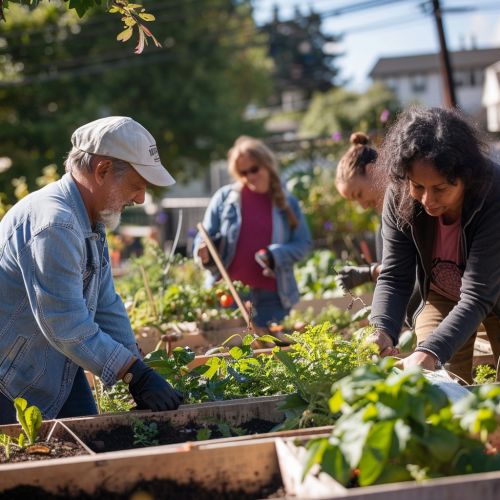Community Development
Introduction
Community development is a process where community members come together to take collective action and generate solutions to common problems. It is a broad term that encompasses various practices aimed at improving the social, economic, and environmental well-being of communities. The goal of community development is to create stronger and more resilient communities by fostering social cohesion, economic opportunity, and environmental sustainability.
Historical Background
Community development has its roots in various social movements and practices throughout history. Early forms of community development can be traced back to the Settlement Movement in the late 19th and early 20th centuries, which aimed to improve the living conditions of the urban poor through education, advocacy, and social services. The movement was characterized by the establishment of settlement houses, such as Hull House in Chicago, which provided a range of services to immigrants and low-income families.
In the mid-20th century, community development gained prominence as a formal field of practice and study. The War on Poverty in the United States, initiated in the 1960s, led to the creation of various community development programs and policies aimed at addressing poverty and inequality. During this period, the concept of community participation became central to community development, emphasizing the importance of involving community members in decision-making processes.
Theories and Models
Community development is informed by various theories and models that provide frameworks for understanding and addressing community issues. Some of the key theories and models include:
Asset-Based Community Development (ABCD)
Asset-Based Community Development (ABCD) is a model that focuses on identifying and leveraging the existing strengths and assets within a community. Rather than focusing on the deficiencies or needs of a community, ABCD emphasizes the potential and capabilities of community members and resources. This approach encourages community members to take an active role in the development process and fosters a sense of ownership and empowerment.
Social Capital Theory
Social capital theory posits that social networks and relationships within a community are valuable resources that can be leveraged for collective action and community development. Social capital is often divided into three types: bonding social capital (strong ties within a close-knit group), bridging social capital (connections between diverse groups), and linking social capital (relationships with institutions and organizations). High levels of social capital are associated with increased trust, cooperation, and civic engagement.
Participatory Development
Participatory development is an approach that emphasizes the active involvement of community members in the planning, implementation, and evaluation of development projects. This approach is based on the belief that community members are best positioned to identify their needs and develop appropriate solutions. Participatory development often involves techniques such as Participatory Rural Appraisal (PRA) and Community-Based Participatory Research (CBPR), which facilitate inclusive and collaborative processes.
Key Components
Community development encompasses several key components that contribute to the overall well-being of a community. These components include:
Economic Development
Economic development is a critical aspect of community development, focusing on improving the economic conditions and opportunities within a community. This can involve initiatives such as job creation, workforce development, small business support, and infrastructure improvements. Economic development aims to create sustainable economic growth and reduce poverty and inequality.
Social Development
Social development involves efforts to improve the social well-being of community members. This can include initiatives related to education, healthcare, housing, and social services. Social development aims to enhance the quality of life, promote social inclusion, and address social issues such as discrimination and inequality.
Environmental Sustainability
Environmental sustainability is an important component of community development, focusing on the responsible use and management of natural resources. This can involve initiatives related to conservation, renewable energy, waste management, and climate change adaptation. Environmental sustainability aims to create resilient communities that can thrive in the face of environmental challenges.
Community Empowerment
Community empowerment is a process that enables community members to gain control over their lives and influence the decisions that affect them. This can involve capacity-building initiatives, leadership development, and advocacy efforts. Community empowerment aims to foster a sense of agency and self-determination among community members.
Methods and Approaches
Community development practitioners use a variety of methods and approaches to engage with communities and address their needs. Some of the common methods and approaches include:
Community Needs Assessment
A community needs assessment is a systematic process used to identify the needs and priorities of a community. This process often involves collecting and analyzing data through surveys, interviews, focus groups, and community meetings. The findings from a community needs assessment can inform the development of programs and policies that address the identified needs.
Community Organizing
Community organizing is a strategy that involves mobilizing community members to take collective action on issues that affect their lives. This can involve building coalitions, conducting advocacy campaigns, and engaging in direct action. Community organizing aims to build power and influence within the community to effect change.
Capacity Building
Capacity building involves efforts to enhance the skills, knowledge, and resources of community members and organizations. This can include training programs, technical assistance, and organizational development support. Capacity building aims to strengthen the ability of communities to address their own needs and sustain development efforts.
Participatory Planning
Participatory planning is an approach that involves community members in the planning and decision-making processes for development projects. This can include activities such as visioning exercises, participatory mapping, and community workshops. Participatory planning aims to ensure that development initiatives are responsive to the needs and aspirations of the community.
Challenges and Criticisms
Community development faces several challenges and criticisms that can impact its effectiveness. Some of the common challenges and criticisms include:
Power Dynamics
Power dynamics within a community can influence the outcomes of community development efforts. Issues such as unequal power relations, marginalization, and exclusion can hinder the participation and empowerment of certain groups. Addressing power dynamics requires a conscious effort to promote inclusivity and equity in community development processes.
Sustainability
Ensuring the sustainability of community development initiatives is a significant challenge. Factors such as limited funding, lack of capacity, and changing political and economic conditions can impact the long-term viability of development efforts. Sustainability requires careful planning, resource mobilization, and ongoing support.
Measurement and Evaluation
Measuring and evaluating the impact of community development initiatives can be complex. Traditional evaluation methods may not capture the full range of social, economic, and environmental outcomes. Developing appropriate indicators and evaluation frameworks is essential for assessing the effectiveness of community development efforts.
Criticisms of Participatory Approaches
While participatory approaches are widely advocated, they are not without criticisms. Some critics argue that participatory processes can be time-consuming and resource-intensive. Additionally, there is a risk of tokenism, where participation is superficial and does not lead to meaningful change. Ensuring genuine and effective participation requires careful design and facilitation of participatory processes.
Case Studies
Examining case studies of community development initiatives can provide valuable insights into the practices and outcomes of community development. Some notable case studies include:
Mondragon Corporation
The Mondragon Corporation in Spain is a well-known example of successful community development through cooperative enterprise. Founded in 1956, Mondragon is a federation of worker cooperatives that operate in various sectors, including manufacturing, finance, and retail. The cooperative model has contributed to economic stability, job creation, and social cohesion in the Basque region.
Grameen Bank
The Grameen Bank in Bangladesh is a pioneering example of community development through microfinance. Founded by Muhammad Yunus in 1983, Grameen Bank provides small loans to low-income individuals, particularly women, to start or expand small businesses. The microfinance model has been credited with reducing poverty and empowering marginalized communities.
Harlem Children's Zone
The Harlem Children's Zone (HCZ) in New York City is a comprehensive community development initiative aimed at breaking the cycle of poverty in Harlem. Founded by Geoffrey Canada in 1997, HCZ provides a range of services, including education, health care, and social support, to children and families. The initiative has been recognized for its holistic approach and positive impact on educational outcomes.
Future Directions
The field of community development continues to evolve, with emerging trends and future directions shaping its practice. Some of the key trends and future directions include:
Digital Inclusion
Digital inclusion is becoming increasingly important in community development, as access to technology and digital literacy are essential for participation in the modern economy and society. Initiatives aimed at bridging the digital divide, such as providing internet access and digital skills training, are critical for ensuring that all community members can benefit from technological advancements.
Climate Resilience
As communities face the growing impacts of climate change, building climate resilience is a key priority for community development. This involves developing strategies to mitigate and adapt to climate-related risks, such as extreme weather events, sea-level rise, and changing agricultural conditions. Community-based approaches to climate resilience emphasize local knowledge and participation in developing sustainable solutions.
Social Innovation
Social innovation involves developing new and creative solutions to social problems. In the context of community development, social innovation can include initiatives such as social enterprises, community-led design, and collaborative platforms. Social innovation aims to address complex social challenges in innovative and impactful ways.
Global Partnerships
Global partnerships and collaborations are becoming increasingly important in community development. International organizations, governments, and non-governmental organizations (NGOs) are working together to address global challenges such as poverty, inequality, and environmental sustainability. These partnerships facilitate the exchange of knowledge, resources, and best practices across communities and regions.
Conclusion
Community development is a dynamic and multifaceted field that plays a crucial role in improving the well-being of communities. By fostering social cohesion, economic opportunity, and environmental sustainability, community development initiatives contribute to the creation of stronger and more resilient communities. As the field continues to evolve, it is essential to address challenges, embrace emerging trends, and promote inclusive and participatory approaches to ensure the success and sustainability of community development efforts.


